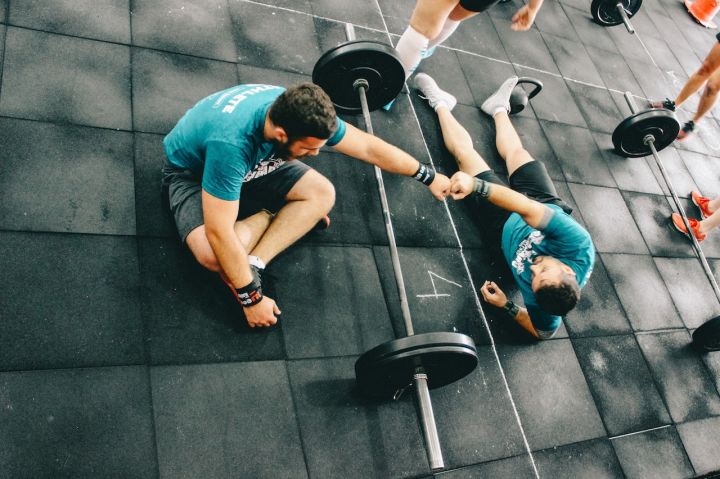The Disadvantages Of Both The Deep Squat And The Hard Pull Are Dissolved By It, What Is This Miracle Move?
poor proprioception is a common problem for many people who are new to the gym. For example, if you are asked to bend your hips, those with poor proprioception will unconsciously bend their knees in sync.
This is why squats and hard pulls are a relatively difficult movement for newbies. Is there any movement that solves the problem of squatting and pulling at once?
It doesn't sound reasonable at all! But the truth is that there is, and many gyms are equipped with this equipment, which is the hexagonal barbell.

the hexagonal barbell hard pull is what we call a hybrid movement, a mix of the squat and the hard pull. Due to the construction of the hexagonal barbell, it is safer and easier to learn compared to the traditional hard pull.
The hexagonal shape allows you to stand up with the weight inside the barbell. Unlike traditional hard pulls, it allows the pressure to be directed away from the back as the athlete can stand straighter. The hexagonal barbell eliminates the need to keep the barbell close to the shins, therefore eliminating many of the dangers of traditional hard pulls.
It raises testosterone and growth hormone levels better than most movements; it builds total body strength; it is certainly a compound movement; and when done with a hexagonal barbell it is clearly a free weight movement.

introduction to the hexagonal barbell hard pull
starting position
1. Place the hexagonal barbell on the floor and load the barbell plates. Place the same weight on both ends of the barbell.
2. Step into the centre of the hexagon with parallel handles on either side.
3. Squat down and grab the handles on either side of the barbell. Ensure that your hands are held vertically in the middle of the handles to maintain balance.
4. Lower your hips, extend your chest and lock your lower back, keeping your head up, eyes forward and knees above your feet. This is the starting position.
Movement execution (action)
1. Power through your legs and lift the barbell straight up.
2. Once you are fully on your feet, one movement is complete. You are now ready for the next movement.
3. Continue squatting down, again keeping your lower back locked, chest extended and eyes forward.

key benefits of the hexagonal barbell hard pull
due to the unique design of the hexagonal barbell, the weight can be kept in line with the power line throughout the lift. With hands on either side of the body rather than having to hold the barbell in front of the body, the hexagonal barbell makes it easier for you to finish with proper form in the hard pull. Doing hard pulls in this way allows for more effective strength growth than traditional hard pulls. The hexagonal barbell is safer and reduces the vertical force on the spine. The hexagonal barbell is more beginner friendly. The movement is easier to learn than a straight bar. The hexagonal barbell can produce higher peak strength than a traditional hard pull, a point that may be suspect to some readers.

hex barbells with extended handles are excellent for taller athletes, people with lower back or hip flexibility problems. The standard hexagonal barbell is also a space-saving tool. It is only 56 inches long, compared to the 86 inches of space occupied by a regular olympic barbell. This allows for many hexagonal barbells to be placed in a small area.
In addition, the shorter the length of the bar, the smaller the distance between the weight and the gym-goer. This gives the gym-goer more control and balance for a more effective, higher intensity workout.

additional tips for the hexagonal barbell hard pull
to minimise the stress on your back, you should gently bounce the weight off the floor as you perform the movement. In other words, do not pause or relax the lower back muscles when lowering the barbell between movements.
Also, keep your head up and your chin away from your chest. If the chin touches the chest, the whole body is in danger of losing its stable position.

muscles involved in the hexagonal barbell hard pull
because the hip, knee and ankle joints are all mobile, the hexagonal barbell hard pull is a multi-joint movement. In addition to the lumbar muscles, the hexagonal barbell hard pull involves many muscles: Latissimus dorsi, gluteus maximus, hamstrings and quadriceps.
Primary muscles: Erector spinae, gluteus maximus, hamstrings
secondary muscles: Obliques, latissimus dorsi, quadriceps, forearms

alternative movements
best alternative exercises.
Traditional hard pull romanian hard pull
the hard pull may seem simple, but it is actually a very technical movement. Therefore, it may not be the best movement for isolating the back. In addition, the hard pull is still much more dangerous for the spine than other isolation movements such as the goat jerk.
If you don't like any type of hard pull, you can easily replace the hard pull with other lower back movements (erector spinae movements) from our database of movements.

the hexagonal barbell hard pull, on the other hand, is a perfect combination of the deep squat and the conventional hard pull, with a little more quadriceps involvement than the straight bar hard pull and a little more hamstring involvement than the conventional squat. It looks to have made up for the lack of conventional movements. The benefits from the hexagonal hard pull are manifold.a
